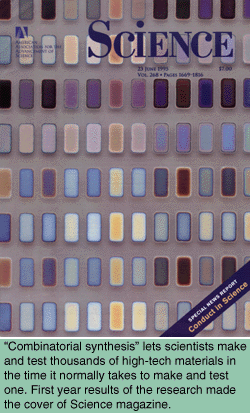

Supercomputing: Berkeley's Beehive Of Science
Tiny Metal Libraries A Big Tool For Materials Scientists


Tiny Metal Libraries A Big Tool For Materials Scientists
by Mike Wooldridge
Berkeley Lab scientists have quickened the pace at which researchers can create and test new advanced materials from the current rate of about one compound a day to as many as 10,000. Working at the Lab's Molecular Design Institute, they have found a way to deposit thousands of distinct combinations of metal-oxide molecules onto an area the size of a checkerboard square, thereby creating the first "combinatorial" library of advanced materials.

Berkeley Lab physicist Xiao-Dong Xiang and chemist Peter Schultz first described the research in a cover story in the June 1995, issue of the journal Science. The technique uses "masks" to stencil thin layers of metal-oxide ingredients onto different columns and rows of a square-inch grid.
Four months later, Xiang and Schultz again reported in Science that they had used combinatorial synthesis to discover new magnetoresistive (MR) compounds, materials whose electrical conductivity changes in a magnetic field.
"The technique is a powerful way to examine a broad base of advanced materials," Xiang said. "Magnetoresistant materials are just the first."
The combinatorial strategy is in contrast to so-called rational design, where researchers try to predict beforehand which molecular structures will yield desired properties. The new strategy relies more on brute force-making a myriad of theoretical candidates and sorting through the bunch to find a solution.
A high-volume strategy makes sense considering the wide range of possibilities scientists are faced with when concocting new materials. Just the five-element combinations available on the periodic chart means millions of potential compounds. The result is an enormous advanced materials "universe," much of which scientists still know very little about.
"In the vast majority of cases, the important discoveries in materials science are serendipitous," Xiang says. "It is very difficult to predict how these complex structures will behave before you make them." Until now, scientists have had to resort to making new materials by trial and error one at a time.
The combinatorial approach has long been known as a way in which the human body solves problems. The immune system, for instance, has a library of about one trillion differently shaped antibodies, each made up of different combinations of protein chains. When faced with an invading agent, such as a virus, the immune system selects from among the trillion antibodies those that happen to bind to the virus. Their numbers are multiplied to fight the infection.
The key point is that there is no rational design of antibodies to fit a particular virus. The strategy is to create a wide variety of combinations that you can select from after the fact.
Previously, Schultz has borrowed the immune system's combinatorial strategy to invent "catalytic" antibodies-antibodies that, because of their shape, promote certain chemical reactions. Similarly, biotechnology researchers have used a combinatorial approach to select potentially useful drugs from large libraries of randomly generated molecules.
To apply the same philosophy to materials design, the researchers turned to thin-film technology, a method in which very small amounts of a complex metal material can be manufactured quickly. Metal components are laid down atop one another, each layer 10 to 100 angstroms in thickness. The layers are heated to mix the metal elements and create a stable, composite compound.
In combinatorial synthesis, the researchers create arrangements of unique metal combinations by depositing the thin films through masks. A so-called primary mask, with square openings like those on a screen door, is used to lay the metals down as a grid of separate squares.

The researchers began with a well-studied class of MR materials based on manganese oxide. They substituted similar elements from the periodic table-iron, vanadium and cobalt-for manganese, and made a separate combinatorial library for each one. They then scanned the libraries for material combinations with magnetoresistance.
The researchers found the most success with the cobalt oxide library, which yielded 26 new MR materials. The materials showed resistance changes as high as 72 percent, making the cobalt oxides similar to the so-called "colossal" class of MR materials. Colossal MR materials lose a great deal of their resistance in magnetic fields, some as much as 99.99 percent.


